Analysis of Leadership Dynamics: Stanford Prison Experiment Report
VerifiedAdded on 2021/09/16
|11
|2638
|179
Report
AI Summary
This report delves into the Stanford Prison Experiment, examining its implications for organizational leadership. The analysis focuses on key elements such as traits, power dynamics, and the effectiveness of leadership styles within the context of the experiment. The report explores the influence of the OCEAN model, ethical considerations, and the development of personal leadership. It investigates how situational aspects can create negative leadership outcomes and the impact of power perception on behavior. Through a detailed examination of the experiment's findings, the report provides insights into the complexities of leadership, the misuse of authority, and the ethical challenges that arise in organizational settings. The study highlights the importance of responsible leadership, the potential for abuse of power, and the need for ethical considerations in decision-making, drawing on the experiment to illustrate how individuals respond to authority and the consequences of such interactions.
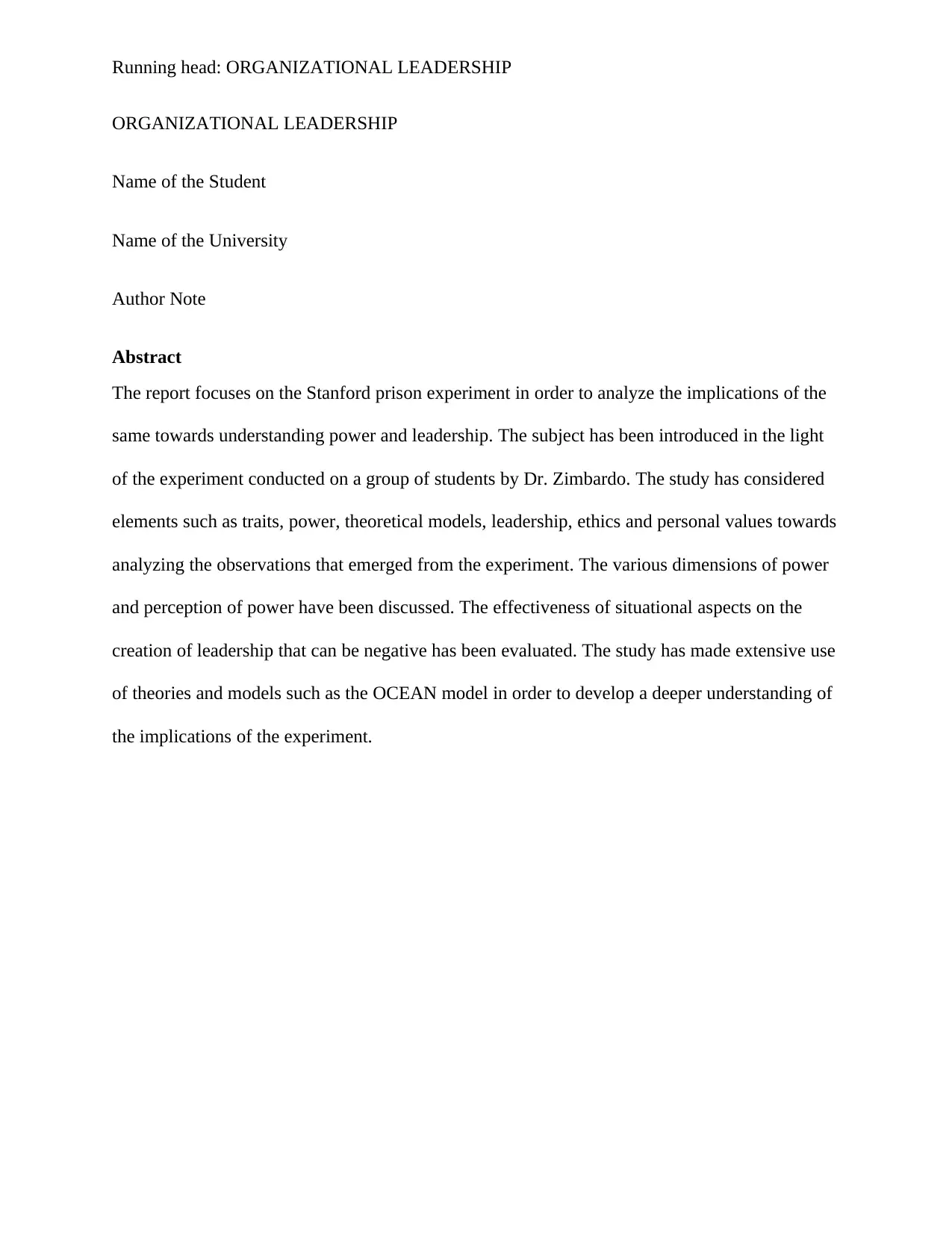
Running head: ORGANIZATIONAL LEADERSHIP
ORGANIZATIONAL LEADERSHIP
Name of the Student
Name of the University
Author Note
Abstract
The report focuses on the Stanford prison experiment in order to analyze the implications of the
same towards understanding power and leadership. The subject has been introduced in the light
of the experiment conducted on a group of students by Dr. Zimbardo. The study has considered
elements such as traits, power, theoretical models, leadership, ethics and personal values towards
analyzing the observations that emerged from the experiment. The various dimensions of power
and perception of power have been discussed. The effectiveness of situational aspects on the
creation of leadership that can be negative has been evaluated. The study has made extensive use
of theories and models such as the OCEAN model in order to develop a deeper understanding of
the implications of the experiment.
ORGANIZATIONAL LEADERSHIP
Name of the Student
Name of the University
Author Note
Abstract
The report focuses on the Stanford prison experiment in order to analyze the implications of the
same towards understanding power and leadership. The subject has been introduced in the light
of the experiment conducted on a group of students by Dr. Zimbardo. The study has considered
elements such as traits, power, theoretical models, leadership, ethics and personal values towards
analyzing the observations that emerged from the experiment. The various dimensions of power
and perception of power have been discussed. The effectiveness of situational aspects on the
creation of leadership that can be negative has been evaluated. The study has made extensive use
of theories and models such as the OCEAN model in order to develop a deeper understanding of
the implications of the experiment.
Paraphrase This Document
Need a fresh take? Get an instant paraphrase of this document with our AI Paraphraser
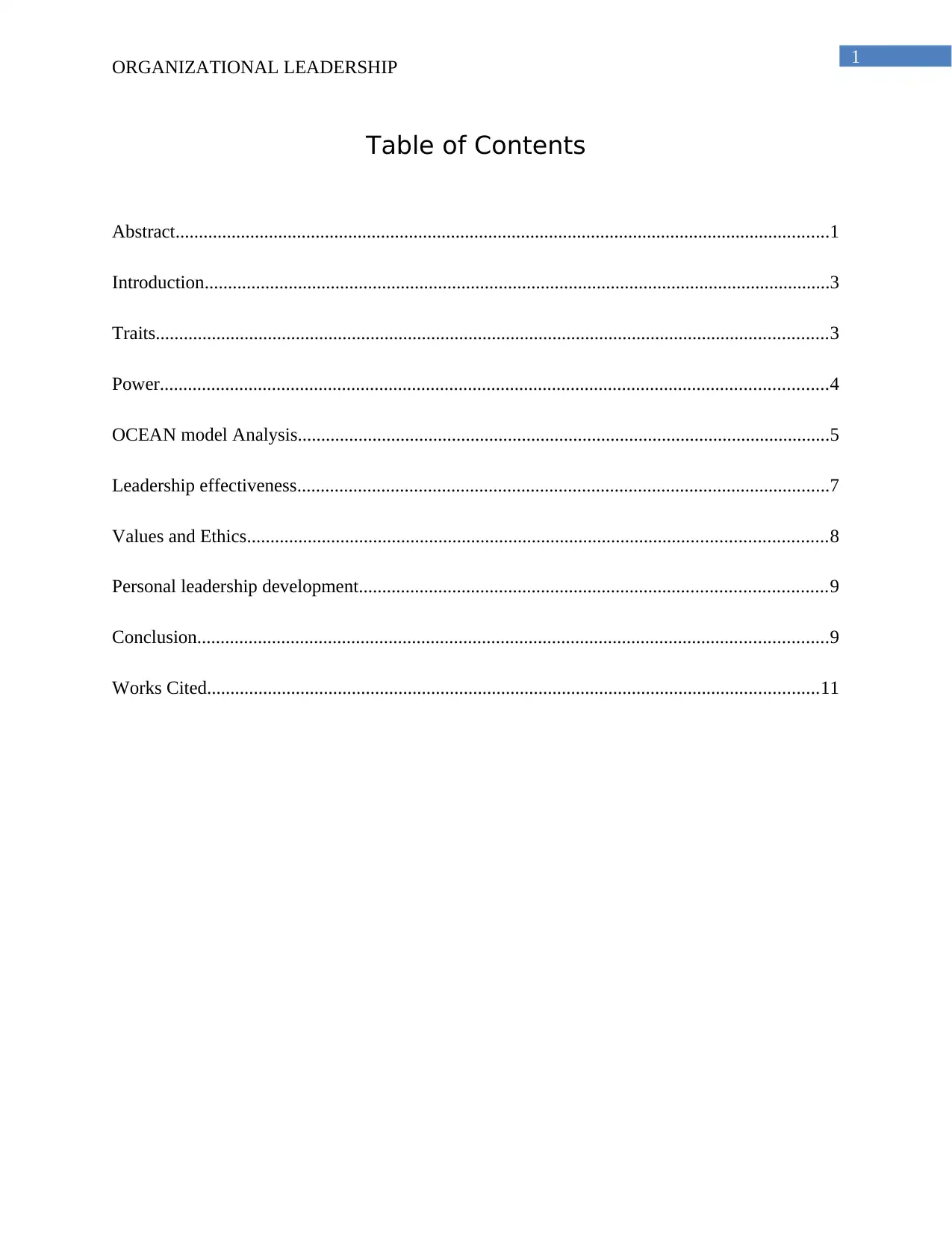
1
ORGANIZATIONAL LEADERSHIP
Table of Contents
Abstract............................................................................................................................................1
Introduction......................................................................................................................................3
Traits................................................................................................................................................3
Power...............................................................................................................................................4
OCEAN model Analysis..................................................................................................................5
Leadership effectiveness..................................................................................................................7
Values and Ethics............................................................................................................................8
Personal leadership development....................................................................................................9
Conclusion.......................................................................................................................................9
Works Cited...................................................................................................................................11
ORGANIZATIONAL LEADERSHIP
Table of Contents
Abstract............................................................................................................................................1
Introduction......................................................................................................................................3
Traits................................................................................................................................................3
Power...............................................................................................................................................4
OCEAN model Analysis..................................................................................................................5
Leadership effectiveness..................................................................................................................7
Values and Ethics............................................................................................................................8
Personal leadership development....................................................................................................9
Conclusion.......................................................................................................................................9
Works Cited...................................................................................................................................11
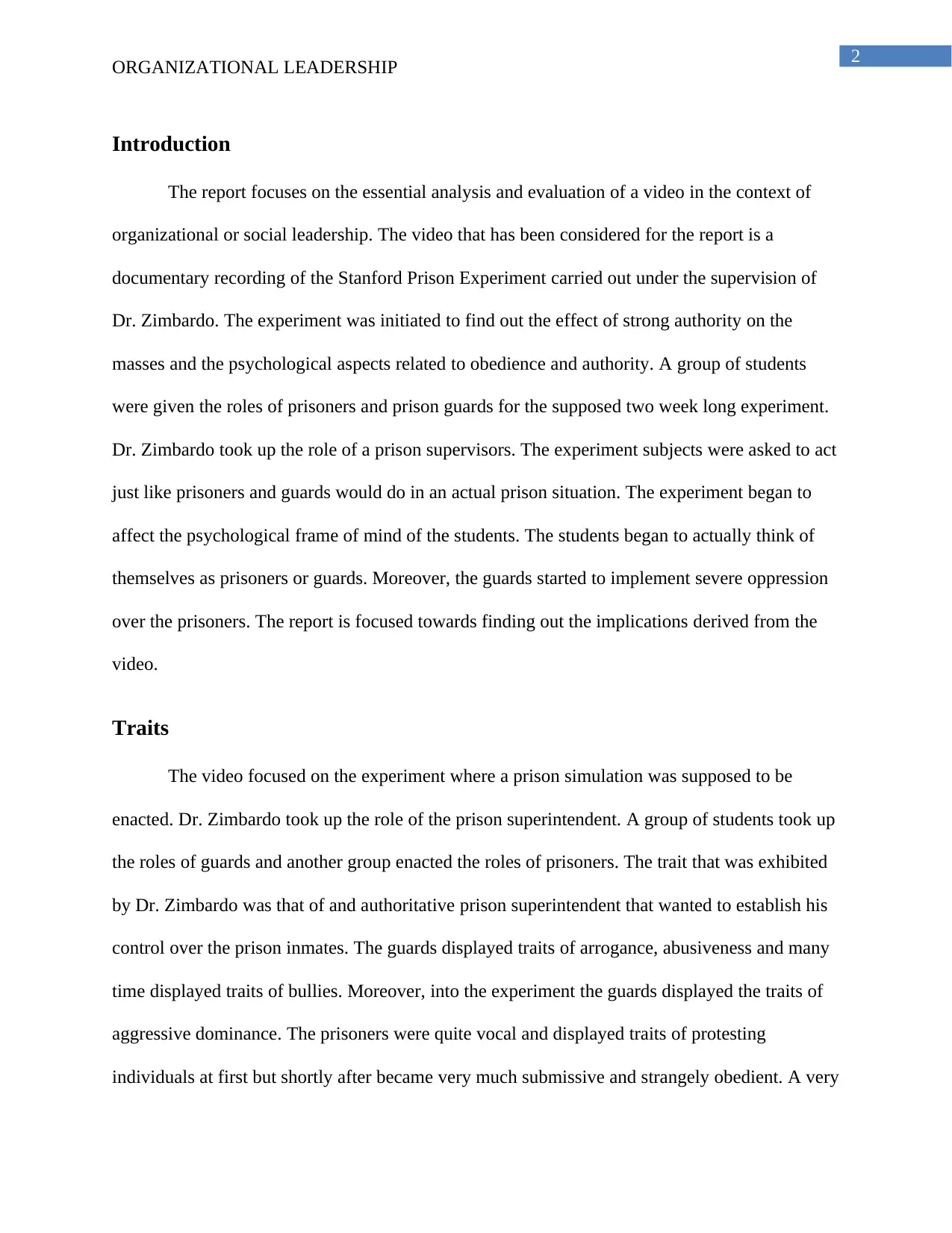
2
ORGANIZATIONAL LEADERSHIP
Introduction
The report focuses on the essential analysis and evaluation of a video in the context of
organizational or social leadership. The video that has been considered for the report is a
documentary recording of the Stanford Prison Experiment carried out under the supervision of
Dr. Zimbardo. The experiment was initiated to find out the effect of strong authority on the
masses and the psychological aspects related to obedience and authority. A group of students
were given the roles of prisoners and prison guards for the supposed two week long experiment.
Dr. Zimbardo took up the role of a prison supervisors. The experiment subjects were asked to act
just like prisoners and guards would do in an actual prison situation. The experiment began to
affect the psychological frame of mind of the students. The students began to actually think of
themselves as prisoners or guards. Moreover, the guards started to implement severe oppression
over the prisoners. The report is focused towards finding out the implications derived from the
video.
Traits
The video focused on the experiment where a prison simulation was supposed to be
enacted. Dr. Zimbardo took up the role of the prison superintendent. A group of students took up
the roles of guards and another group enacted the roles of prisoners. The trait that was exhibited
by Dr. Zimbardo was that of and authoritative prison superintendent that wanted to establish his
control over the prison inmates. The guards displayed traits of arrogance, abusiveness and many
time displayed traits of bullies. Moreover, into the experiment the guards displayed the traits of
aggressive dominance. The prisoners were quite vocal and displayed traits of protesting
individuals at first but shortly after became very much submissive and strangely obedient. A very
ORGANIZATIONAL LEADERSHIP
Introduction
The report focuses on the essential analysis and evaluation of a video in the context of
organizational or social leadership. The video that has been considered for the report is a
documentary recording of the Stanford Prison Experiment carried out under the supervision of
Dr. Zimbardo. The experiment was initiated to find out the effect of strong authority on the
masses and the psychological aspects related to obedience and authority. A group of students
were given the roles of prisoners and prison guards for the supposed two week long experiment.
Dr. Zimbardo took up the role of a prison supervisors. The experiment subjects were asked to act
just like prisoners and guards would do in an actual prison situation. The experiment began to
affect the psychological frame of mind of the students. The students began to actually think of
themselves as prisoners or guards. Moreover, the guards started to implement severe oppression
over the prisoners. The report is focused towards finding out the implications derived from the
video.
Traits
The video focused on the experiment where a prison simulation was supposed to be
enacted. Dr. Zimbardo took up the role of the prison superintendent. A group of students took up
the roles of guards and another group enacted the roles of prisoners. The trait that was exhibited
by Dr. Zimbardo was that of and authoritative prison superintendent that wanted to establish his
control over the prison inmates. The guards displayed traits of arrogance, abusiveness and many
time displayed traits of bullies. Moreover, into the experiment the guards displayed the traits of
aggressive dominance. The prisoners were quite vocal and displayed traits of protesting
individuals at first but shortly after became very much submissive and strangely obedient. A very
⊘ This is a preview!⊘
Do you want full access?
Subscribe today to unlock all pages.

Trusted by 1+ million students worldwide
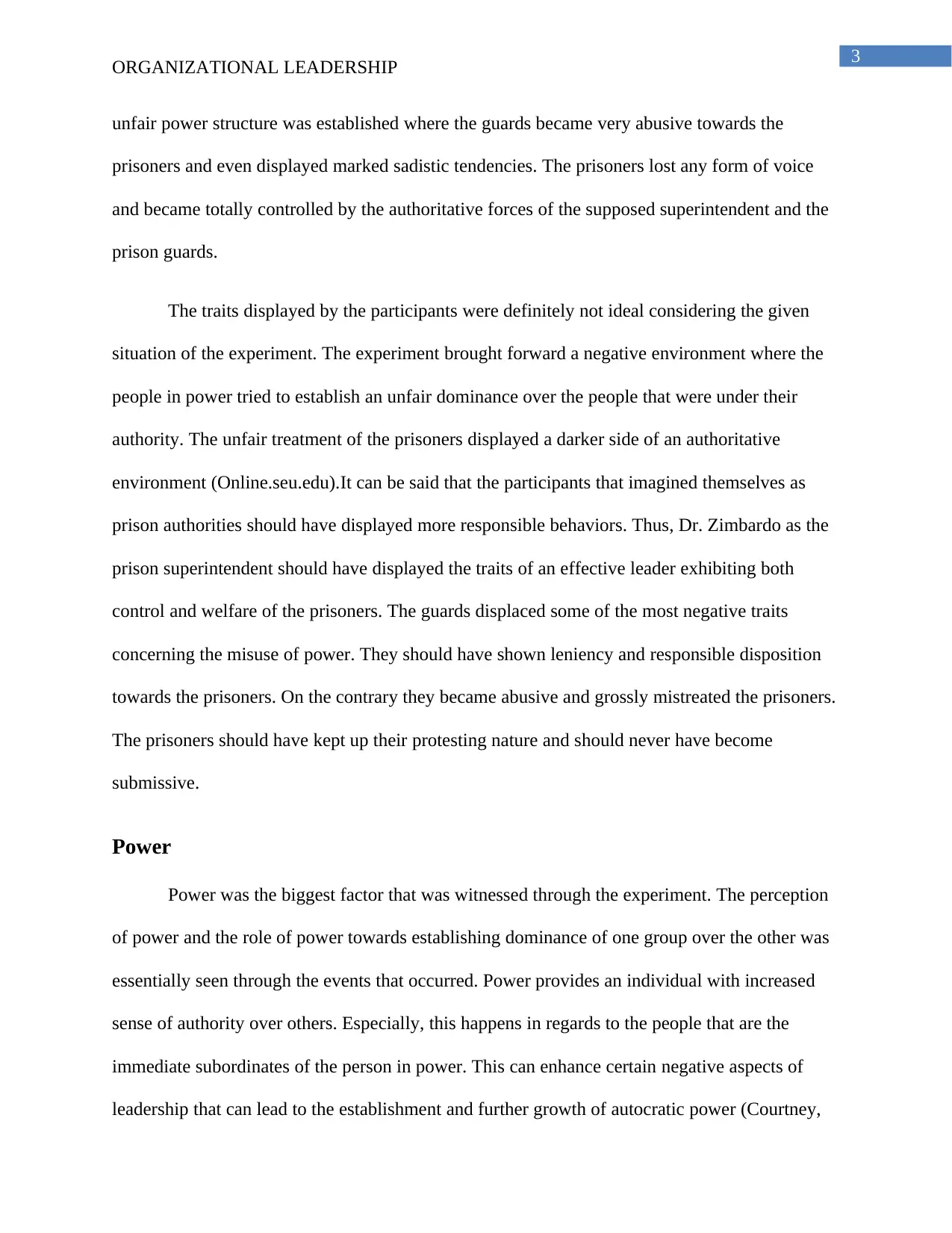
3
ORGANIZATIONAL LEADERSHIP
unfair power structure was established where the guards became very abusive towards the
prisoners and even displayed marked sadistic tendencies. The prisoners lost any form of voice
and became totally controlled by the authoritative forces of the supposed superintendent and the
prison guards.
The traits displayed by the participants were definitely not ideal considering the given
situation of the experiment. The experiment brought forward a negative environment where the
people in power tried to establish an unfair dominance over the people that were under their
authority. The unfair treatment of the prisoners displayed a darker side of an authoritative
environment (Online.seu.edu).It can be said that the participants that imagined themselves as
prison authorities should have displayed more responsible behaviors. Thus, Dr. Zimbardo as the
prison superintendent should have displayed the traits of an effective leader exhibiting both
control and welfare of the prisoners. The guards displaced some of the most negative traits
concerning the misuse of power. They should have shown leniency and responsible disposition
towards the prisoners. On the contrary they became abusive and grossly mistreated the prisoners.
The prisoners should have kept up their protesting nature and should never have become
submissive.
Power
Power was the biggest factor that was witnessed through the experiment. The perception
of power and the role of power towards establishing dominance of one group over the other was
essentially seen through the events that occurred. Power provides an individual with increased
sense of authority over others. Especially, this happens in regards to the people that are the
immediate subordinates of the person in power. This can enhance certain negative aspects of
leadership that can lead to the establishment and further growth of autocratic power (Courtney,
ORGANIZATIONAL LEADERSHIP
unfair power structure was established where the guards became very abusive towards the
prisoners and even displayed marked sadistic tendencies. The prisoners lost any form of voice
and became totally controlled by the authoritative forces of the supposed superintendent and the
prison guards.
The traits displayed by the participants were definitely not ideal considering the given
situation of the experiment. The experiment brought forward a negative environment where the
people in power tried to establish an unfair dominance over the people that were under their
authority. The unfair treatment of the prisoners displayed a darker side of an authoritative
environment (Online.seu.edu).It can be said that the participants that imagined themselves as
prison authorities should have displayed more responsible behaviors. Thus, Dr. Zimbardo as the
prison superintendent should have displayed the traits of an effective leader exhibiting both
control and welfare of the prisoners. The guards displaced some of the most negative traits
concerning the misuse of power. They should have shown leniency and responsible disposition
towards the prisoners. On the contrary they became abusive and grossly mistreated the prisoners.
The prisoners should have kept up their protesting nature and should never have become
submissive.
Power
Power was the biggest factor that was witnessed through the experiment. The perception
of power and the role of power towards establishing dominance of one group over the other was
essentially seen through the events that occurred. Power provides an individual with increased
sense of authority over others. Especially, this happens in regards to the people that are the
immediate subordinates of the person in power. This can enhance certain negative aspects of
leadership that can lead to the establishment and further growth of autocratic power (Courtney,
Paraphrase This Document
Need a fresh take? Get an instant paraphrase of this document with our AI Paraphraser
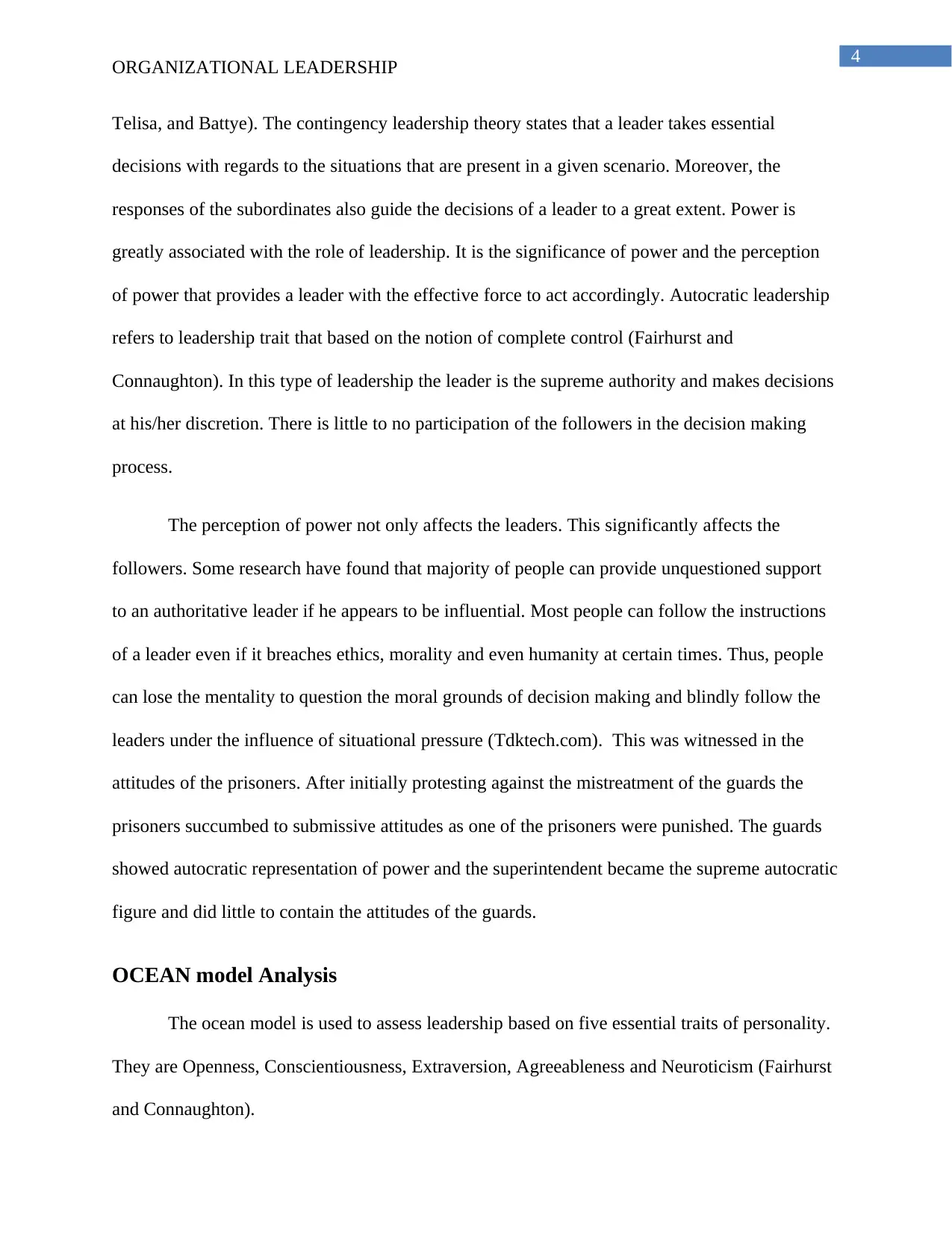
4
ORGANIZATIONAL LEADERSHIP
Telisa, and Battye). The contingency leadership theory states that a leader takes essential
decisions with regards to the situations that are present in a given scenario. Moreover, the
responses of the subordinates also guide the decisions of a leader to a great extent. Power is
greatly associated with the role of leadership. It is the significance of power and the perception
of power that provides a leader with the effective force to act accordingly. Autocratic leadership
refers to leadership trait that based on the notion of complete control (Fairhurst and
Connaughton). In this type of leadership the leader is the supreme authority and makes decisions
at his/her discretion. There is little to no participation of the followers in the decision making
process.
The perception of power not only affects the leaders. This significantly affects the
followers. Some research have found that majority of people can provide unquestioned support
to an authoritative leader if he appears to be influential. Most people can follow the instructions
of a leader even if it breaches ethics, morality and even humanity at certain times. Thus, people
can lose the mentality to question the moral grounds of decision making and blindly follow the
leaders under the influence of situational pressure (Tdktech.com). This was witnessed in the
attitudes of the prisoners. After initially protesting against the mistreatment of the guards the
prisoners succumbed to submissive attitudes as one of the prisoners were punished. The guards
showed autocratic representation of power and the superintendent became the supreme autocratic
figure and did little to contain the attitudes of the guards.
OCEAN model Analysis
The ocean model is used to assess leadership based on five essential traits of personality.
They are Openness, Conscientiousness, Extraversion, Agreeableness and Neuroticism (Fairhurst
and Connaughton).
ORGANIZATIONAL LEADERSHIP
Telisa, and Battye). The contingency leadership theory states that a leader takes essential
decisions with regards to the situations that are present in a given scenario. Moreover, the
responses of the subordinates also guide the decisions of a leader to a great extent. Power is
greatly associated with the role of leadership. It is the significance of power and the perception
of power that provides a leader with the effective force to act accordingly. Autocratic leadership
refers to leadership trait that based on the notion of complete control (Fairhurst and
Connaughton). In this type of leadership the leader is the supreme authority and makes decisions
at his/her discretion. There is little to no participation of the followers in the decision making
process.
The perception of power not only affects the leaders. This significantly affects the
followers. Some research have found that majority of people can provide unquestioned support
to an authoritative leader if he appears to be influential. Most people can follow the instructions
of a leader even if it breaches ethics, morality and even humanity at certain times. Thus, people
can lose the mentality to question the moral grounds of decision making and blindly follow the
leaders under the influence of situational pressure (Tdktech.com). This was witnessed in the
attitudes of the prisoners. After initially protesting against the mistreatment of the guards the
prisoners succumbed to submissive attitudes as one of the prisoners were punished. The guards
showed autocratic representation of power and the superintendent became the supreme autocratic
figure and did little to contain the attitudes of the guards.
OCEAN model Analysis
The ocean model is used to assess leadership based on five essential traits of personality.
They are Openness, Conscientiousness, Extraversion, Agreeableness and Neuroticism (Fairhurst
and Connaughton).
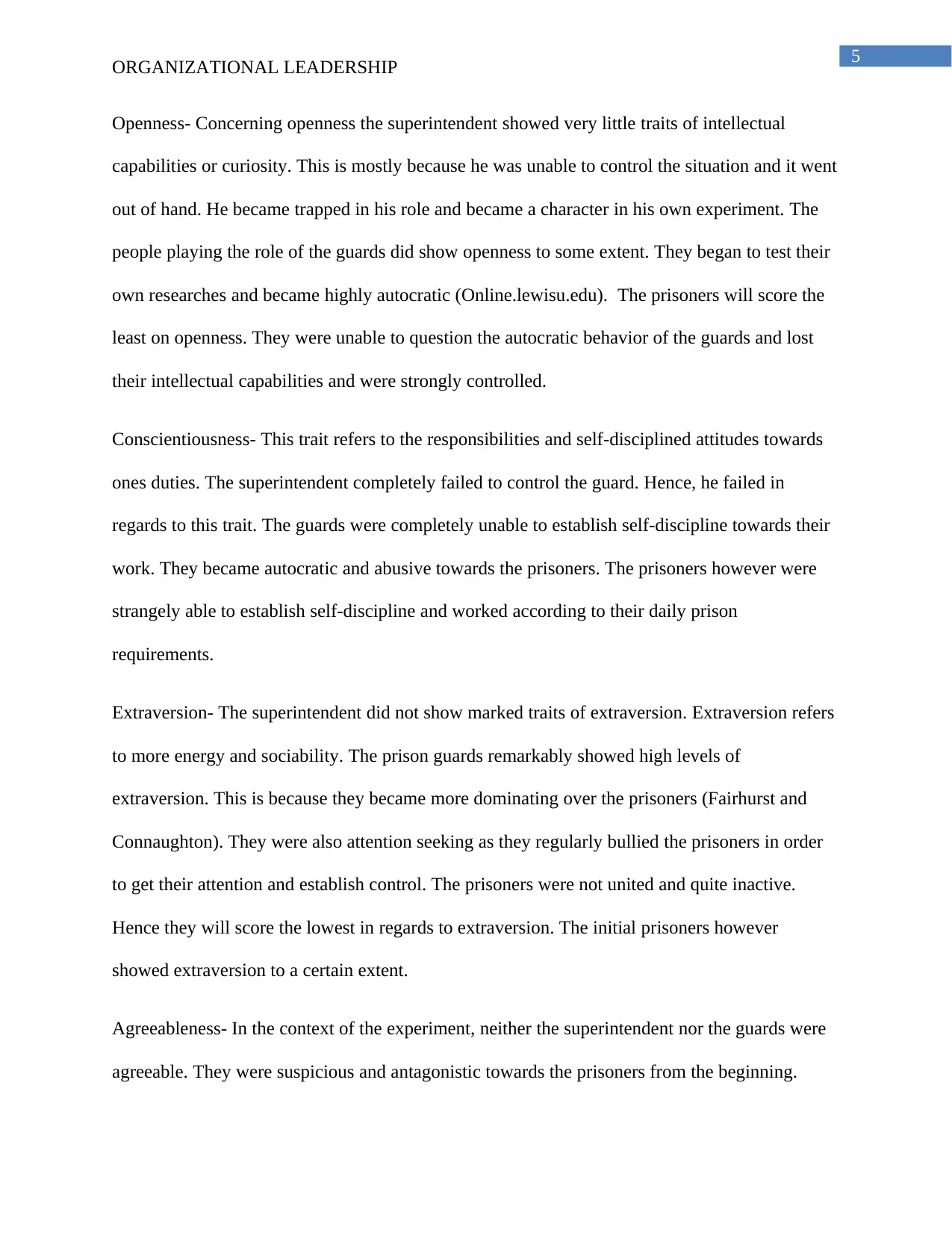
5
ORGANIZATIONAL LEADERSHIP
Openness- Concerning openness the superintendent showed very little traits of intellectual
capabilities or curiosity. This is mostly because he was unable to control the situation and it went
out of hand. He became trapped in his role and became a character in his own experiment. The
people playing the role of the guards did show openness to some extent. They began to test their
own researches and became highly autocratic (Online.lewisu.edu). The prisoners will score the
least on openness. They were unable to question the autocratic behavior of the guards and lost
their intellectual capabilities and were strongly controlled.
Conscientiousness- This trait refers to the responsibilities and self-disciplined attitudes towards
ones duties. The superintendent completely failed to control the guard. Hence, he failed in
regards to this trait. The guards were completely unable to establish self-discipline towards their
work. They became autocratic and abusive towards the prisoners. The prisoners however were
strangely able to establish self-discipline and worked according to their daily prison
requirements.
Extraversion- The superintendent did not show marked traits of extraversion. Extraversion refers
to more energy and sociability. The prison guards remarkably showed high levels of
extraversion. This is because they became more dominating over the prisoners (Fairhurst and
Connaughton). They were also attention seeking as they regularly bullied the prisoners in order
to get their attention and establish control. The prisoners were not united and quite inactive.
Hence they will score the lowest in regards to extraversion. The initial prisoners however
showed extraversion to a certain extent.
Agreeableness- In the context of the experiment, neither the superintendent nor the guards were
agreeable. They were suspicious and antagonistic towards the prisoners from the beginning.
ORGANIZATIONAL LEADERSHIP
Openness- Concerning openness the superintendent showed very little traits of intellectual
capabilities or curiosity. This is mostly because he was unable to control the situation and it went
out of hand. He became trapped in his role and became a character in his own experiment. The
people playing the role of the guards did show openness to some extent. They began to test their
own researches and became highly autocratic (Online.lewisu.edu). The prisoners will score the
least on openness. They were unable to question the autocratic behavior of the guards and lost
their intellectual capabilities and were strongly controlled.
Conscientiousness- This trait refers to the responsibilities and self-disciplined attitudes towards
ones duties. The superintendent completely failed to control the guard. Hence, he failed in
regards to this trait. The guards were completely unable to establish self-discipline towards their
work. They became autocratic and abusive towards the prisoners. The prisoners however were
strangely able to establish self-discipline and worked according to their daily prison
requirements.
Extraversion- The superintendent did not show marked traits of extraversion. Extraversion refers
to more energy and sociability. The prison guards remarkably showed high levels of
extraversion. This is because they became more dominating over the prisoners (Fairhurst and
Connaughton). They were also attention seeking as they regularly bullied the prisoners in order
to get their attention and establish control. The prisoners were not united and quite inactive.
Hence they will score the lowest in regards to extraversion. The initial prisoners however
showed extraversion to a certain extent.
Agreeableness- In the context of the experiment, neither the superintendent nor the guards were
agreeable. They were suspicious and antagonistic towards the prisoners from the beginning.
⊘ This is a preview!⊘
Do you want full access?
Subscribe today to unlock all pages.

Trusted by 1+ million students worldwide
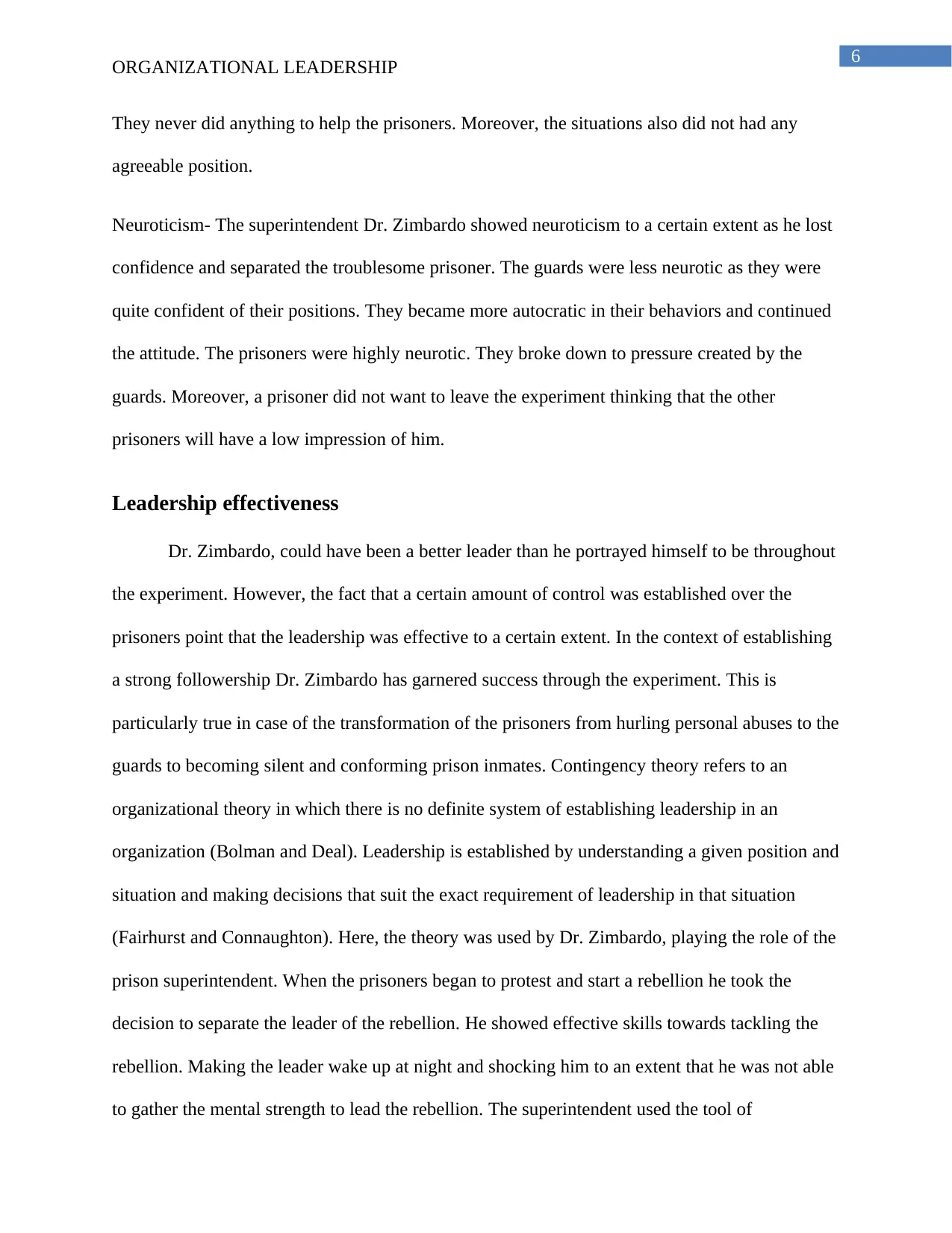
6
ORGANIZATIONAL LEADERSHIP
They never did anything to help the prisoners. Moreover, the situations also did not had any
agreeable position.
Neuroticism- The superintendent Dr. Zimbardo showed neuroticism to a certain extent as he lost
confidence and separated the troublesome prisoner. The guards were less neurotic as they were
quite confident of their positions. They became more autocratic in their behaviors and continued
the attitude. The prisoners were highly neurotic. They broke down to pressure created by the
guards. Moreover, a prisoner did not want to leave the experiment thinking that the other
prisoners will have a low impression of him.
Leadership effectiveness
Dr. Zimbardo, could have been a better leader than he portrayed himself to be throughout
the experiment. However, the fact that a certain amount of control was established over the
prisoners point that the leadership was effective to a certain extent. In the context of establishing
a strong followership Dr. Zimbardo has garnered success through the experiment. This is
particularly true in case of the transformation of the prisoners from hurling personal abuses to the
guards to becoming silent and conforming prison inmates. Contingency theory refers to an
organizational theory in which there is no definite system of establishing leadership in an
organization (Bolman and Deal). Leadership is established by understanding a given position and
situation and making decisions that suit the exact requirement of leadership in that situation
(Fairhurst and Connaughton). Here, the theory was used by Dr. Zimbardo, playing the role of the
prison superintendent. When the prisoners began to protest and start a rebellion he took the
decision to separate the leader of the rebellion. He showed effective skills towards tackling the
rebellion. Making the leader wake up at night and shocking him to an extent that he was not able
to gather the mental strength to lead the rebellion. The superintendent used the tool of
ORGANIZATIONAL LEADERSHIP
They never did anything to help the prisoners. Moreover, the situations also did not had any
agreeable position.
Neuroticism- The superintendent Dr. Zimbardo showed neuroticism to a certain extent as he lost
confidence and separated the troublesome prisoner. The guards were less neurotic as they were
quite confident of their positions. They became more autocratic in their behaviors and continued
the attitude. The prisoners were highly neurotic. They broke down to pressure created by the
guards. Moreover, a prisoner did not want to leave the experiment thinking that the other
prisoners will have a low impression of him.
Leadership effectiveness
Dr. Zimbardo, could have been a better leader than he portrayed himself to be throughout
the experiment. However, the fact that a certain amount of control was established over the
prisoners point that the leadership was effective to a certain extent. In the context of establishing
a strong followership Dr. Zimbardo has garnered success through the experiment. This is
particularly true in case of the transformation of the prisoners from hurling personal abuses to the
guards to becoming silent and conforming prison inmates. Contingency theory refers to an
organizational theory in which there is no definite system of establishing leadership in an
organization (Bolman and Deal). Leadership is established by understanding a given position and
situation and making decisions that suit the exact requirement of leadership in that situation
(Fairhurst and Connaughton). Here, the theory was used by Dr. Zimbardo, playing the role of the
prison superintendent. When the prisoners began to protest and start a rebellion he took the
decision to separate the leader of the rebellion. He showed effective skills towards tackling the
rebellion. Making the leader wake up at night and shocking him to an extent that he was not able
to gather the mental strength to lead the rebellion. The superintendent used the tool of
Paraphrase This Document
Need a fresh take? Get an instant paraphrase of this document with our AI Paraphraser
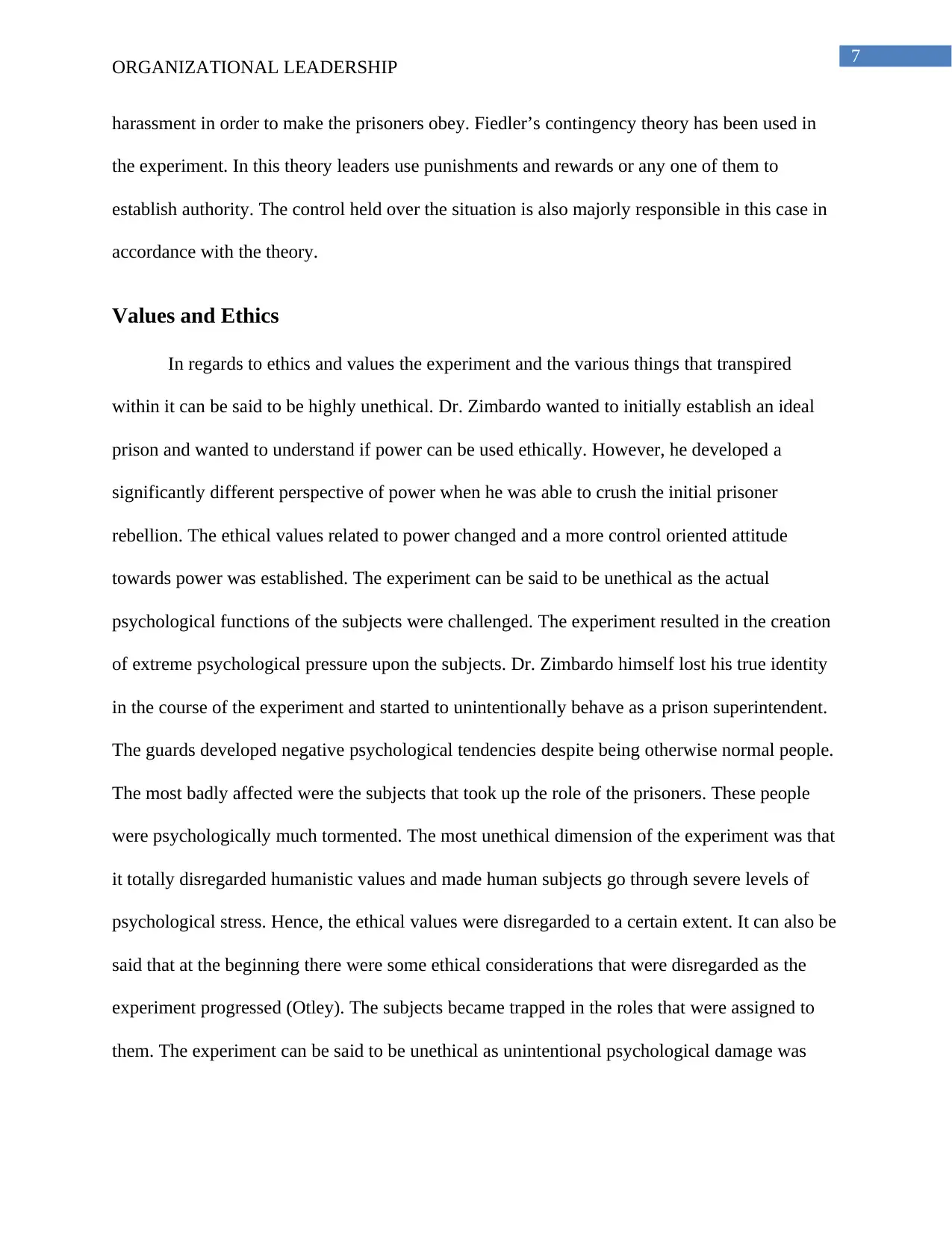
7
ORGANIZATIONAL LEADERSHIP
harassment in order to make the prisoners obey. Fiedler’s contingency theory has been used in
the experiment. In this theory leaders use punishments and rewards or any one of them to
establish authority. The control held over the situation is also majorly responsible in this case in
accordance with the theory.
Values and Ethics
In regards to ethics and values the experiment and the various things that transpired
within it can be said to be highly unethical. Dr. Zimbardo wanted to initially establish an ideal
prison and wanted to understand if power can be used ethically. However, he developed a
significantly different perspective of power when he was able to crush the initial prisoner
rebellion. The ethical values related to power changed and a more control oriented attitude
towards power was established. The experiment can be said to be unethical as the actual
psychological functions of the subjects were challenged. The experiment resulted in the creation
of extreme psychological pressure upon the subjects. Dr. Zimbardo himself lost his true identity
in the course of the experiment and started to unintentionally behave as a prison superintendent.
The guards developed negative psychological tendencies despite being otherwise normal people.
The most badly affected were the subjects that took up the role of the prisoners. These people
were psychologically much tormented. The most unethical dimension of the experiment was that
it totally disregarded humanistic values and made human subjects go through severe levels of
psychological stress. Hence, the ethical values were disregarded to a certain extent. It can also be
said that at the beginning there were some ethical considerations that were disregarded as the
experiment progressed (Otley). The subjects became trapped in the roles that were assigned to
them. The experiment can be said to be unethical as unintentional psychological damage was
ORGANIZATIONAL LEADERSHIP
harassment in order to make the prisoners obey. Fiedler’s contingency theory has been used in
the experiment. In this theory leaders use punishments and rewards or any one of them to
establish authority. The control held over the situation is also majorly responsible in this case in
accordance with the theory.
Values and Ethics
In regards to ethics and values the experiment and the various things that transpired
within it can be said to be highly unethical. Dr. Zimbardo wanted to initially establish an ideal
prison and wanted to understand if power can be used ethically. However, he developed a
significantly different perspective of power when he was able to crush the initial prisoner
rebellion. The ethical values related to power changed and a more control oriented attitude
towards power was established. The experiment can be said to be unethical as the actual
psychological functions of the subjects were challenged. The experiment resulted in the creation
of extreme psychological pressure upon the subjects. Dr. Zimbardo himself lost his true identity
in the course of the experiment and started to unintentionally behave as a prison superintendent.
The guards developed negative psychological tendencies despite being otherwise normal people.
The most badly affected were the subjects that took up the role of the prisoners. These people
were psychologically much tormented. The most unethical dimension of the experiment was that
it totally disregarded humanistic values and made human subjects go through severe levels of
psychological stress. Hence, the ethical values were disregarded to a certain extent. It can also be
said that at the beginning there were some ethical considerations that were disregarded as the
experiment progressed (Otley). The subjects became trapped in the roles that were assigned to
them. The experiment can be said to be unethical as unintentional psychological damage was
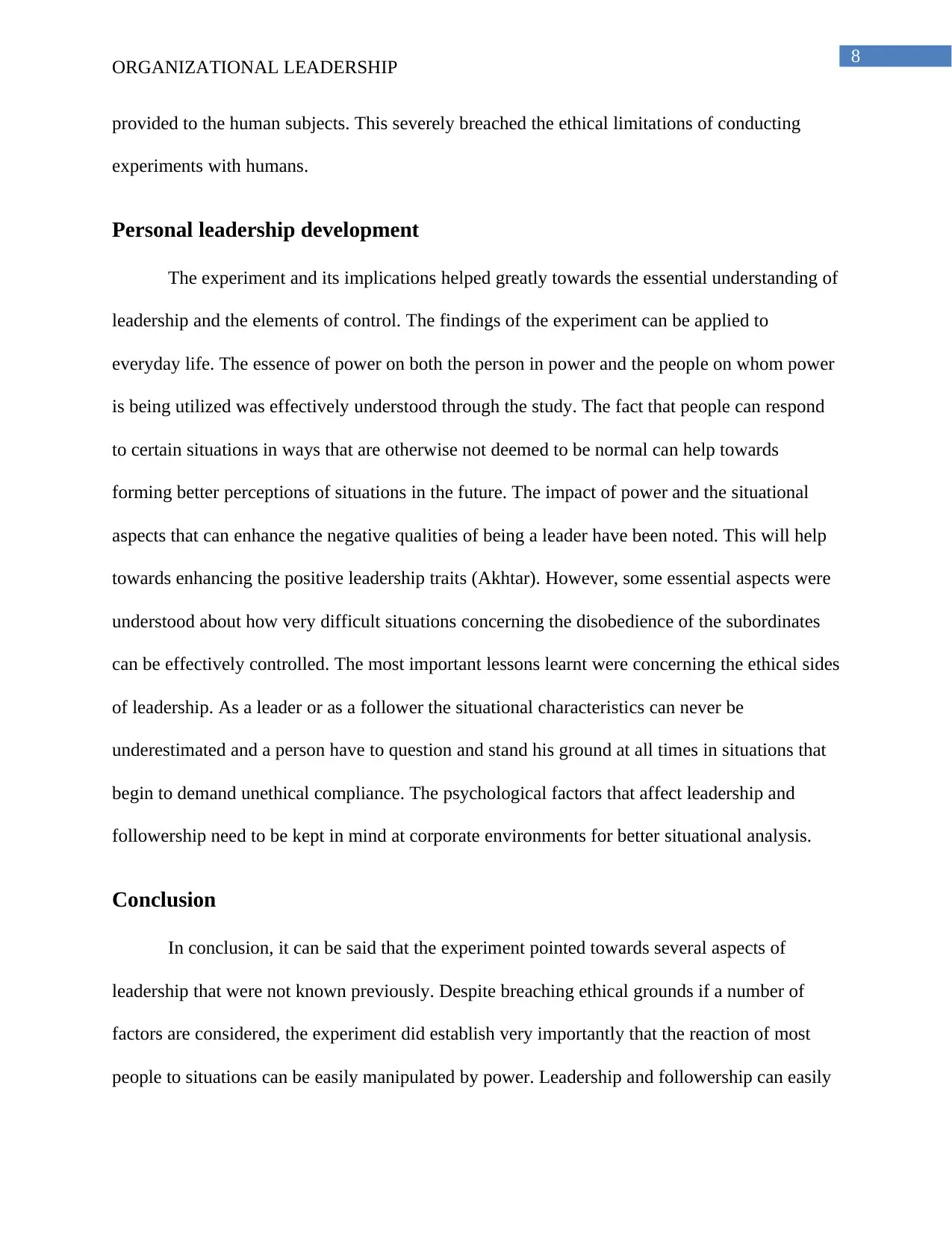
8
ORGANIZATIONAL LEADERSHIP
provided to the human subjects. This severely breached the ethical limitations of conducting
experiments with humans.
Personal leadership development
The experiment and its implications helped greatly towards the essential understanding of
leadership and the elements of control. The findings of the experiment can be applied to
everyday life. The essence of power on both the person in power and the people on whom power
is being utilized was effectively understood through the study. The fact that people can respond
to certain situations in ways that are otherwise not deemed to be normal can help towards
forming better perceptions of situations in the future. The impact of power and the situational
aspects that can enhance the negative qualities of being a leader have been noted. This will help
towards enhancing the positive leadership traits (Akhtar). However, some essential aspects were
understood about how very difficult situations concerning the disobedience of the subordinates
can be effectively controlled. The most important lessons learnt were concerning the ethical sides
of leadership. As a leader or as a follower the situational characteristics can never be
underestimated and a person have to question and stand his ground at all times in situations that
begin to demand unethical compliance. The psychological factors that affect leadership and
followership need to be kept in mind at corporate environments for better situational analysis.
Conclusion
In conclusion, it can be said that the experiment pointed towards several aspects of
leadership that were not known previously. Despite breaching ethical grounds if a number of
factors are considered, the experiment did establish very importantly that the reaction of most
people to situations can be easily manipulated by power. Leadership and followership can easily
ORGANIZATIONAL LEADERSHIP
provided to the human subjects. This severely breached the ethical limitations of conducting
experiments with humans.
Personal leadership development
The experiment and its implications helped greatly towards the essential understanding of
leadership and the elements of control. The findings of the experiment can be applied to
everyday life. The essence of power on both the person in power and the people on whom power
is being utilized was effectively understood through the study. The fact that people can respond
to certain situations in ways that are otherwise not deemed to be normal can help towards
forming better perceptions of situations in the future. The impact of power and the situational
aspects that can enhance the negative qualities of being a leader have been noted. This will help
towards enhancing the positive leadership traits (Akhtar). However, some essential aspects were
understood about how very difficult situations concerning the disobedience of the subordinates
can be effectively controlled. The most important lessons learnt were concerning the ethical sides
of leadership. As a leader or as a follower the situational characteristics can never be
underestimated and a person have to question and stand his ground at all times in situations that
begin to demand unethical compliance. The psychological factors that affect leadership and
followership need to be kept in mind at corporate environments for better situational analysis.
Conclusion
In conclusion, it can be said that the experiment pointed towards several aspects of
leadership that were not known previously. Despite breaching ethical grounds if a number of
factors are considered, the experiment did establish very importantly that the reaction of most
people to situations can be easily manipulated by power. Leadership and followership can easily
⊘ This is a preview!⊘
Do you want full access?
Subscribe today to unlock all pages.

Trusted by 1+ million students worldwide
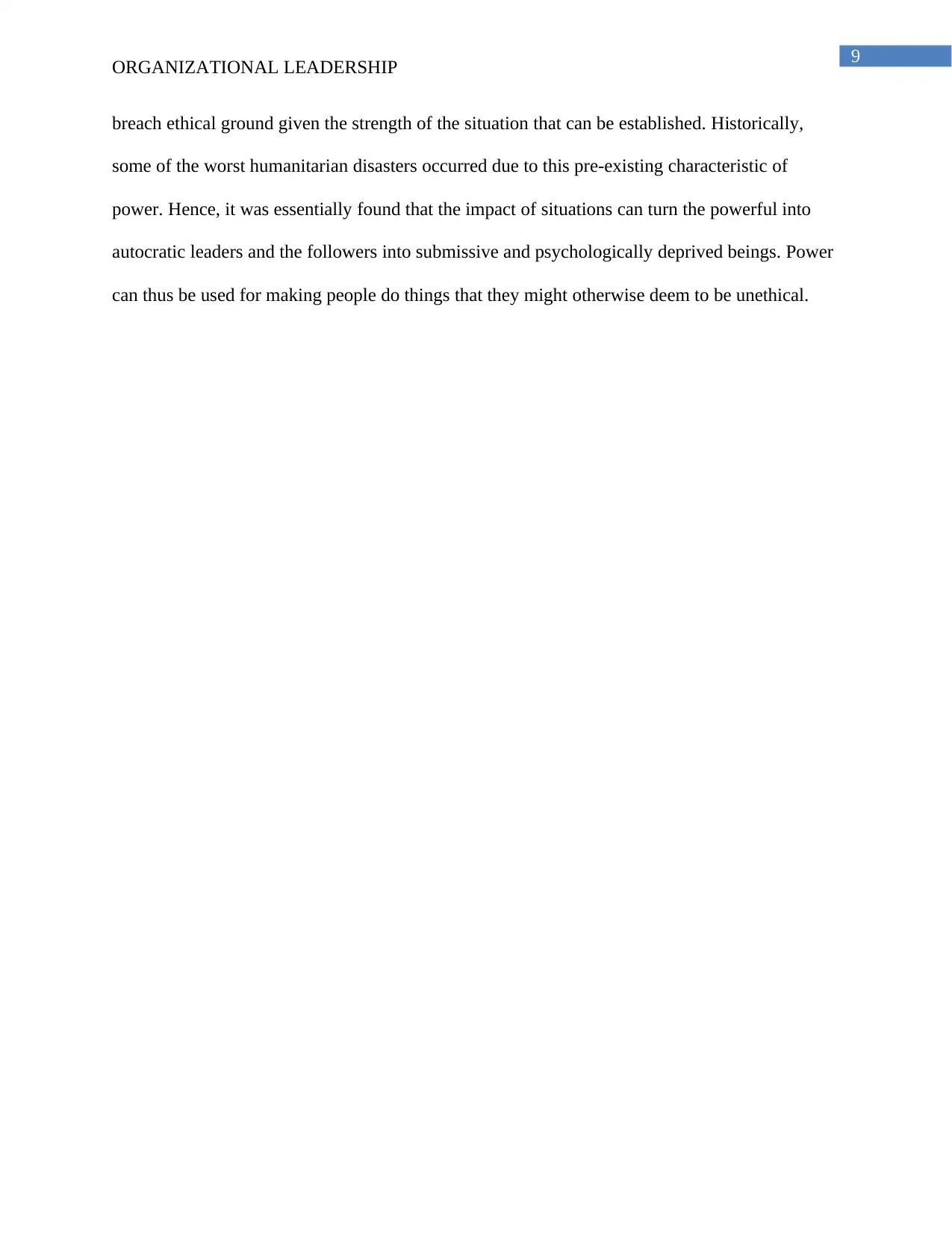
9
ORGANIZATIONAL LEADERSHIP
breach ethical ground given the strength of the situation that can be established. Historically,
some of the worst humanitarian disasters occurred due to this pre-existing characteristic of
power. Hence, it was essentially found that the impact of situations can turn the powerful into
autocratic leaders and the followers into submissive and psychologically deprived beings. Power
can thus be used for making people do things that they might otherwise deem to be unethical.
ORGANIZATIONAL LEADERSHIP
breach ethical ground given the strength of the situation that can be established. Historically,
some of the worst humanitarian disasters occurred due to this pre-existing characteristic of
power. Hence, it was essentially found that the impact of situations can turn the powerful into
autocratic leaders and the followers into submissive and psychologically deprived beings. Power
can thus be used for making people do things that they might otherwise deem to be unethical.
Paraphrase This Document
Need a fresh take? Get an instant paraphrase of this document with our AI Paraphraser
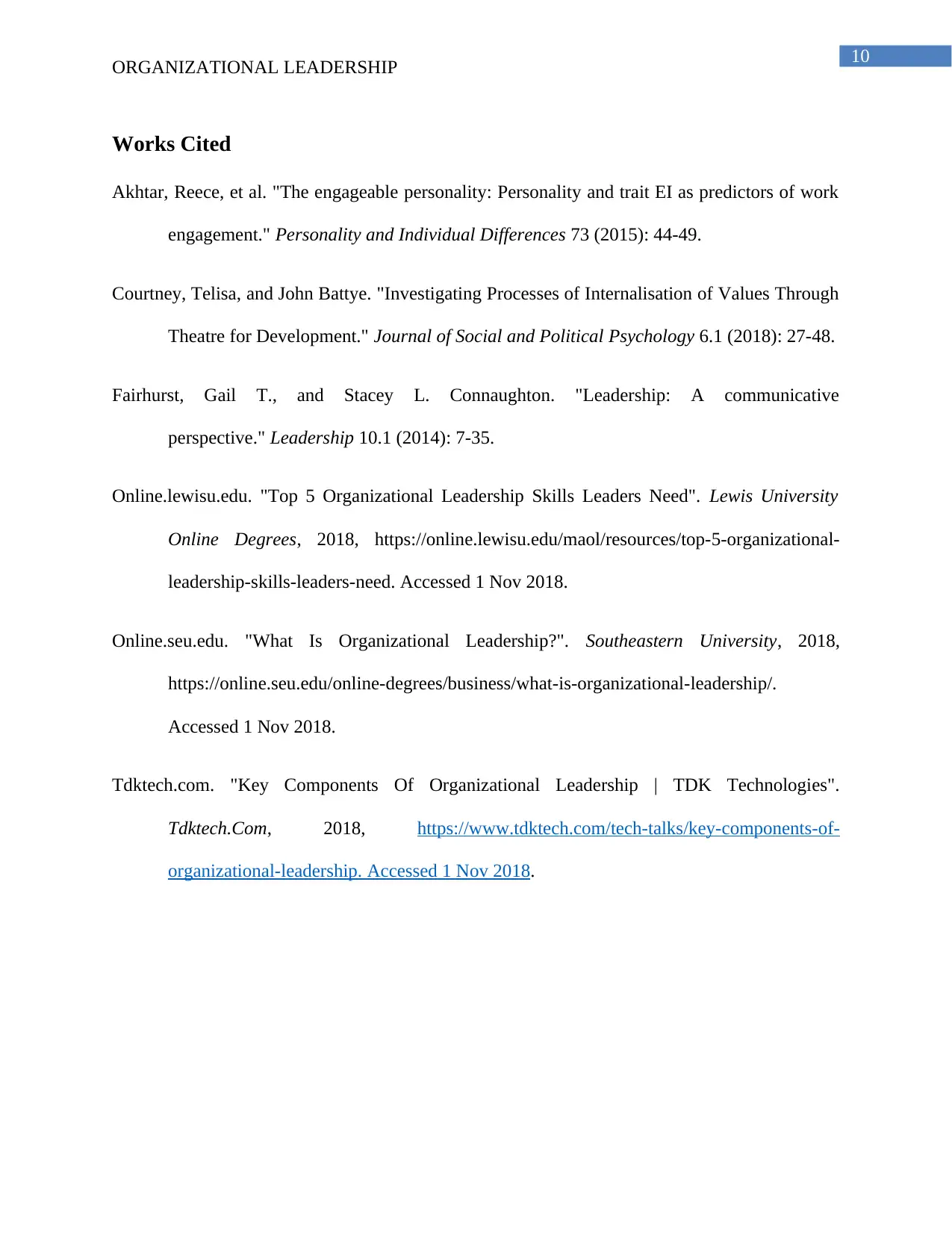
10
ORGANIZATIONAL LEADERSHIP
Works Cited
Akhtar, Reece, et al. "The engageable personality: Personality and trait EI as predictors of work
engagement." Personality and Individual Differences 73 (2015): 44-49.
Courtney, Telisa, and John Battye. "Investigating Processes of Internalisation of Values Through
Theatre for Development." Journal of Social and Political Psychology 6.1 (2018): 27-48.
Fairhurst, Gail T., and Stacey L. Connaughton. "Leadership: A communicative
perspective." Leadership 10.1 (2014): 7-35.
Online.lewisu.edu. "Top 5 Organizational Leadership Skills Leaders Need". Lewis University
Online Degrees, 2018, https://online.lewisu.edu/maol/resources/top-5-organizational-
leadership-skills-leaders-need. Accessed 1 Nov 2018.
Online.seu.edu. "What Is Organizational Leadership?". Southeastern University, 2018,
https://online.seu.edu/online-degrees/business/what-is-organizational-leadership/.
Accessed 1 Nov 2018.
Tdktech.com. "Key Components Of Organizational Leadership | TDK Technologies".
Tdktech.Com, 2018, https://www.tdktech.com/tech-talks/key-components-of-
organizational-leadership. Accessed 1 Nov 2018.
ORGANIZATIONAL LEADERSHIP
Works Cited
Akhtar, Reece, et al. "The engageable personality: Personality and trait EI as predictors of work
engagement." Personality and Individual Differences 73 (2015): 44-49.
Courtney, Telisa, and John Battye. "Investigating Processes of Internalisation of Values Through
Theatre for Development." Journal of Social and Political Psychology 6.1 (2018): 27-48.
Fairhurst, Gail T., and Stacey L. Connaughton. "Leadership: A communicative
perspective." Leadership 10.1 (2014): 7-35.
Online.lewisu.edu. "Top 5 Organizational Leadership Skills Leaders Need". Lewis University
Online Degrees, 2018, https://online.lewisu.edu/maol/resources/top-5-organizational-
leadership-skills-leaders-need. Accessed 1 Nov 2018.
Online.seu.edu. "What Is Organizational Leadership?". Southeastern University, 2018,
https://online.seu.edu/online-degrees/business/what-is-organizational-leadership/.
Accessed 1 Nov 2018.
Tdktech.com. "Key Components Of Organizational Leadership | TDK Technologies".
Tdktech.Com, 2018, https://www.tdktech.com/tech-talks/key-components-of-
organizational-leadership. Accessed 1 Nov 2018.
1 out of 11
Your All-in-One AI-Powered Toolkit for Academic Success.
+13062052269
info@desklib.com
Available 24*7 on WhatsApp / Email
![[object Object]](/_next/static/media/star-bottom.7253800d.svg)
Unlock your academic potential
Copyright © 2020–2025 A2Z Services. All Rights Reserved. Developed and managed by ZUCOL.